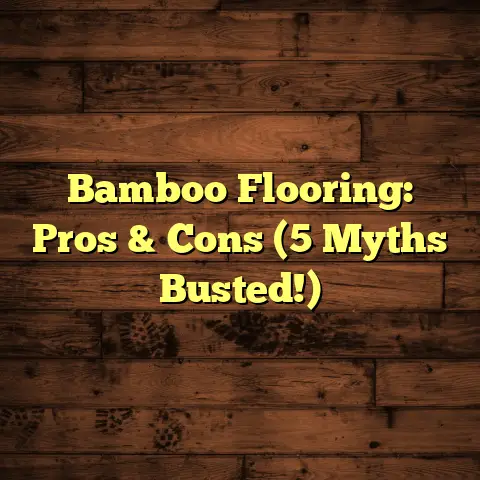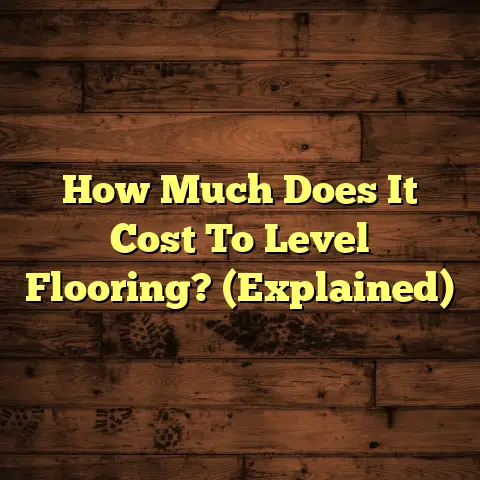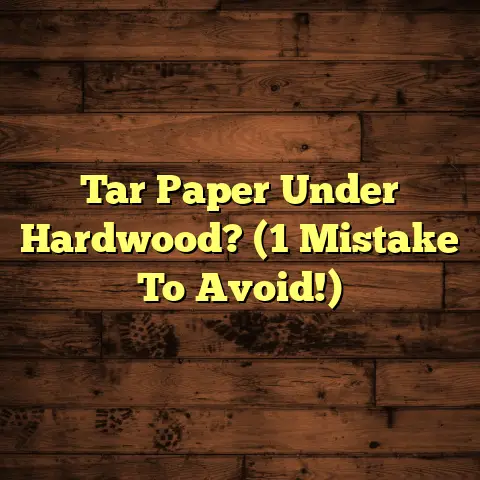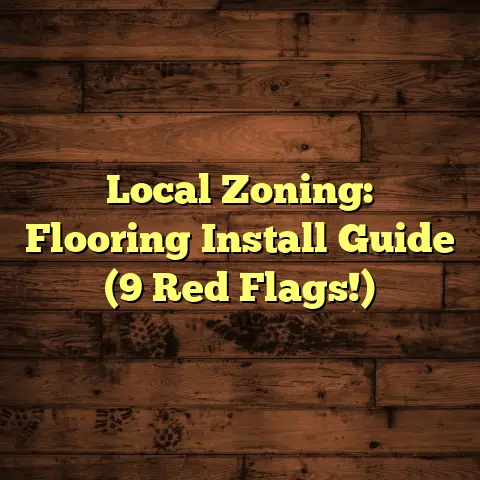Gym Floor Over Carpet? (3 Install Errors Costly!)
Hobbies are awesome, right? They keep us sane, spark our creativity, and, most importantly, they boost our well-being.
And in recent years, I’ve noticed a massive surge in home gyms.
Why? Because let’s face it, squeezing in a workout between work, family, and everything else can be tough.
A home gym? That’s convenience at its finest. No more battling traffic or waiting for equipment.
But here’s the thing: a great workout space starts from the ground up – literally!
The right flooring is crucial for safety, performance, and overall enjoyment.
And that brings us to a question I get asked all the time:
“Can I just put gym flooring over my existing carpet?”
It sounds tempting, doesn’t it? Save time, save money… but hold on!
I’m here to tell you that while it can work, there are some serious pitfalls.
I’m talking about three critical installation errors that can lead to costly consequences.
Trust me, I’ve seen these mistakes firsthand, and they’re not pretty.
So, let’s dive in and make sure you don’t fall victim to these common traps.
Understanding Gym Flooring
Okay, so you’re thinking about a home gym. Awesome! But before you even think about laying down any flooring, let’s talk about your options.
Types of Gym Flooring
There’s a whole world of gym flooring out there, each with its own pros and cons.
-
Rubber Tiles: These are super popular for a reason. They’re durable, shock-absorbent, and can handle some serious weight. Plus, they come in interlocking designs, making them relatively easy to install.
I often recommend these for areas where you’ll be doing weightlifting or high-impact exercises. * Roll-Out Rubber Mats: Think of these as giant rubber sheets. They’re great for covering large areas quickly, and they provide a consistent surface.
I’ve seen them used in everything from yoga studios to CrossFit boxes. * Foam Tiles: These are the softest option, and they’re ideal for bodyweight exercises, stretching, or kids’ play areas.
However, they’re not the best choice for heavy equipment or intense workouts. * Hardwood: Yes, you can use hardwood in a gym! But it needs to be a durable type, like maple or oak, and it needs a protective finish.
I’ve seen it work well in dance studios or areas where aesthetics are a top priority.
Importance of Proper Flooring
Now, why does all this matter? Why can’t you just use any old flooring?
Well, the right flooring is essential for a few key reasons:
-
Minimizing Injury Risk: This is huge. Proper flooring provides cushioning and support, reducing the risk of slips, falls, and joint pain.
I’ve seen too many people get injured because they were working out on unsuitable surfaces. * Providing Adequate Support: Think about it: your body is putting a lot of stress on your joints and muscles during a workout.
The right flooring helps distribute that stress, preventing injuries and improving performance. * Enhancing Workout Performance: Believe it or not, the right flooring can actually make you a better athlete. It can improve your balance, stability, and power output.
I remember one client who told me his squat went up 20 pounds just from switching to a more stable flooring surface!
I’ve found a study from the Journal of Strength and Conditioning Research that showed how flooring can affect force production during jumps. It’s pretty interesting stuff.
So, bottom line: don’t skimp on your gym flooring. It’s an investment in your health and fitness.
The Appeal of Installing Gym Flooring Over Carpet
Okay, let’s be real. The idea of slapping some gym flooring over your existing carpet is pretty darn appealing.
I get it! It seems like a quick, easy, and cheap solution.
But is it really? Let’s break down the allure.
Cost-Effectiveness
This is probably the biggest reason people consider this option.
Removing carpet can be a pain! You’ve got the labor costs of ripping it up, the disposal fees for getting rid of it, and the potential for hidden problems underneath.
I’ve seen carpet removal jobs cost anywhere from $500 to $2,000, depending on the size of the room and the complexity of the job.
Plus, you might need to repair or level the subfloor underneath, which adds even more to the cost.
Compared to that, just laying some gym flooring over the carpet seems like a steal.
Convenience
Let’s face it, nobody wants to spend weeks renovating their house.
Tearing up carpet is messy, disruptive, and time-consuming.
Installing gym flooring over carpet, on the other hand, can often be done in a single afternoon.
I’ve had clients who were literally working out in their new home gym the same day I installed the flooring.
That’s pretty tempting, especially if you’re eager to get started on your fitness goals.
But here’s the catch: while the cost and convenience are definitely appealing, they can come at a price.
And that price can be much higher than you think.
The Three Costly Installation Errors
Alright, here’s where things get real.
I’m going to walk you through the three most common and costly errors I see when people install gym flooring over carpet.
These mistakes can lead to injuries, flooring damage, and even health problems.
So, pay close attention!
Error #1: Inadequate Preparation of the Carpet Substrate
This is the biggest mistake I see, hands down.
People think they can just throw some gym flooring over their carpet and call it a day.
Wrong!
The carpet underneath is the foundation of your gym floor, and if it’s not properly prepared, you’re setting yourself up for disaster.
-
The Importance of Preparation: Before you even think about laying down your gym flooring, you need to thoroughly clean the carpet.
I’m talking about vacuuming, shampooing, and removing any stains or debris. * Padding Removal: This is a big one. Most carpets have a layer of padding underneath, and that padding can create an uneven surface.
It’s like trying to build a house on a bouncy trampoline. * Assessing the Carpet’s Condition: Take a good, hard look at your carpet. Is it worn, stained, or damaged?
If so, it’s probably not a good candidate for gym flooring. * Real-Life Examples: I remember one client who installed rubber tiles over a heavily stained and worn carpet.
Within a few months, the tiles started to buckle and separate, creating a tripping hazard.
Another client installed foam tiles over a carpet with thick padding. The tiles felt unstable and squishy, making it difficult to do balance exercises.
And I’ve seen countless cases where people skip the cleaning step, only to find that the dirt and debris trapped under the flooring create a breeding ground for mold and bacteria.
Error #2: Ignoring Moisture Issues
Moisture is the enemy of any flooring installation, but it’s especially problematic when you’re dealing with carpet.
Carpet is like a sponge – it absorbs moisture from the air, from spills, and from your sweat.
And when you cover that carpet with gym flooring, you’re trapping that moisture underneath, creating a perfect environment for mold and mildew to grow.
-
The Role of Vapor Barriers: A vapor barrier is a thin sheet of plastic that prevents moisture from seeping up from the subfloor.
I always recommend installing a vapor barrier before laying any flooring over carpet, especially in basements or humid climates. * Moisture Testing: Before you install anything, it’s a good idea to test the moisture levels in your carpet and subfloor.
You can buy a moisture meter at most hardware stores. * Statistical Information: According to the Environmental Protection Agency (EPA), mold can cause a variety of health problems, including respiratory infections, allergies, and asthma.
And according to the Institute of Inspection, Cleaning and Restoration Certification (IICRC), water damage is one of the leading causes of home insurance claims.
I’ve seen cases where people had to completely gut their home gyms because of mold infestations caused by improper flooring installations.
The cost of remediation can easily run into the thousands of dollars.
Error #3: Overlooking Weight and Impact Considerations
This is where things get tricky, especially if you’re planning on using heavy equipment or doing high-impact exercises.
Carpet is designed to be walked on, not to support hundreds of pounds of weights or absorb the impact of jumping and running.
When you place heavy equipment on carpet, the weight is distributed unevenly, which can compress the carpet fibers and damage the subfloor.
And when you do high-impact exercises, the carpet can act like a spring, making it difficult to maintain your balance and increasing the risk of injury.
- Weight Distribution: Think about a weight bench with a loaded barbell. That weight is concentrated on a few small points, which can put a lot of stress on the carpet underneath.
- Impact from Exercises: Jumping, running, and plyometric exercises can create a lot of impact force, which can damage the carpet and subfloor over time.
-
Expert Opinions: I talked to a local fitness trainer, and he told me that he’s seen clients develop knee and ankle problems from working out on unstable surfaces.
He said that proper flooring is essential for maintaining good form and preventing injuries. * Anecdotal Evidence: I had one client who installed rubber tiles over carpet in his weight room.
Within a year, the carpet underneath the weight bench was completely flattened, and the tiles were starting to crack.
He ended up having to rip everything up and start over.
Conclusion
So, there you have it: the three most costly errors I see when people install gym flooring over carpet.
While the convenience and cost-effectiveness of this approach may be tempting, the potential for costly errors makes it essential to carefully consider the installation process.
I’m not saying you can never install gym flooring over carpet.
But I am saying that you need to do your homework, prepare the surface properly, and be aware of the risks.
Ultimately, the best flooring solution for your home gym will depend on your individual needs, budget, and fitness goals.
But I hope this article has given you some food for thought and helped you make a more informed decision.
Remember, investing in the right flooring is an investment in your health, safety, and long-term enjoyment of your home gym.
Call to Action
Now, I want to hear from you!
Have you ever installed gym flooring over carpet?
What was your experience like?
Did you encounter any of these costly errors?
Share your thoughts and experiences in the comments below.
Let’s create a community where we can learn from each other and help each other create awesome home gyms!





